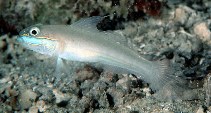| Family: |
Gobiidae (Gobies), subfamily: Gobiinae |
| Max. size: |
16 cm SL (male/unsexed) |
| Environment: |
reef-associated; brackish; marine; depth range 8 - 30 m |
| Distribution: |
Western Pacific: Ryukyu Islands, Philippines, Solomon Islands, Malaysia, Palau, Indonesia and the Great Barrier Reef. |
| Diagnosis: |
Dorsal spines (total): 6-7; Dorsal soft rays (total): 16-18; Anal spines: 1-1; Anal soft rays: 16-18. Characterized by pale grey body color with red and blue-edged blue-green stripe below eye; faint orange stripe along lower side; third dorsal spine longest and prolonged in adult; rhomboid caudal fin, longer than head; longitudinal scale series 76-81; ctenoid body scales, becoming cycloid below first dorsal fin; head or midline of nape without scales; side of nape with scales extending forward to above middle of operculum; fully scaled pectoral fin base and prepelvic area in adult; depth of body 5.0-5.9 in SL (Ref. 90102). |
| Biology: |
Inhabits coastal estuaries and muddy slopes adjacent to algal reef to about 30 meters depth (Ref. 48637). Solitary (Ref. 90102). Found in mud or fine silty sand bottoms, usually in the vicinity of its burrow. |
| IUCN Red List Status: |
Least Concern (LC); Date assessed: 27 August 2020 Ref. (130435)
|
| Threat to humans: |
harmless |
Source and more info: www.fishbase.org. For personal, classroom, and other internal use only. Not for publication.
